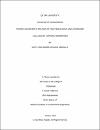Crossflow Microfiltration of Tight Emulsions and Suspended Colloids by Ceramic Membranes
| المرشد | Nasser, Mustafa S. |
| المرشد | Benamor, Abdelbaki |
| المؤلف | Abdalla, Mays Said Abdelrahman |
| تاريخ الإتاحة | 2018-12-19T10:50:17Z |
| تاريخ النشر | 2018-01 |
| الملخص | Produced water is known as the largest waste stream associated with the oil and gas extraction process from onshore and offshore fields; that is found in the form of either oil in water (o/w) or water in oil (o/w) emulsion. It is a very complex mixture composes of a variety of organic, and inorganic chemicals that can be found either suspended or dissolved in the water. During the oil and gas production many problems occur because of the formation of the emulsions. These emulsions can be very tight/stable and difficult to break it, and this is due to their heterogeneous composition. The presence of polar compounds such asphaltenes, surfactants and polymer used during the process and the presence of many types of fine solids such as crystallized wax, clays, and scales that participate in the formation of resistance films at the oil/water interface are known to produce unwanted stable emulsions that generate operational problems and are difficult to break. Therefore, produced water became a global concern and discharging this tremendous amount of water to the environment threatens the aquatic life and destroys the natural resources. The conventional methods in treating tight produced water emulsions and removal of suspended matters of micron size was found to have limitations, thus, there was a need to look for a robust method to solve such problems. The cross-flow ceramic microfiltration membrane is one of the promising solution for the micron-size oil droplets and colloids, yet no much work done using ceramic membrane. To this aim, a cross-flow ceramic microfiltration membrane was used to separate tight oil-in-water emulsions stabilized using Ethylene tetrakis surfactant. Diesel was used as oil source while, bentonite is used as the suspended matter source. The results showed that the cross-flow ceramic microfiltration membrane significantly removes the oil and colloidal suspended matters. It’s worthy to mention that the performance of the membrane was examined to remove the oil, bentonite, and mixture of both oil and bentonite, and it was found that the optimum pressure for the removal of both o/w emulsion-bentonite mixture, and o/w emulsion solution was at 0.5bar, where 90% of the oil content can be removed. On the other hand, the removal of suspended solids from o/w emulsion-bentonite solution was at its maximum under 0.2bar, where almost 99.97% of the suspended solids were removed. The 0.45m ceramic membrane showed that it is a promising technology for treating any wastewater contains tight emulsions and suspended maters. |
| اللغة | en |
| الموضوع | Tight Emulsion O/W Emulsion Microfiltration Ceramic Membrane Colloids Suspended matters Produced water |
| النوع | Master Thesis |
| التخصص | Environmental Engineering |
الملفات في هذه التسجيلة
هذه التسجيلة تظهر في المجموعات التالية
-
الهندسة البيئية [59 items ]


